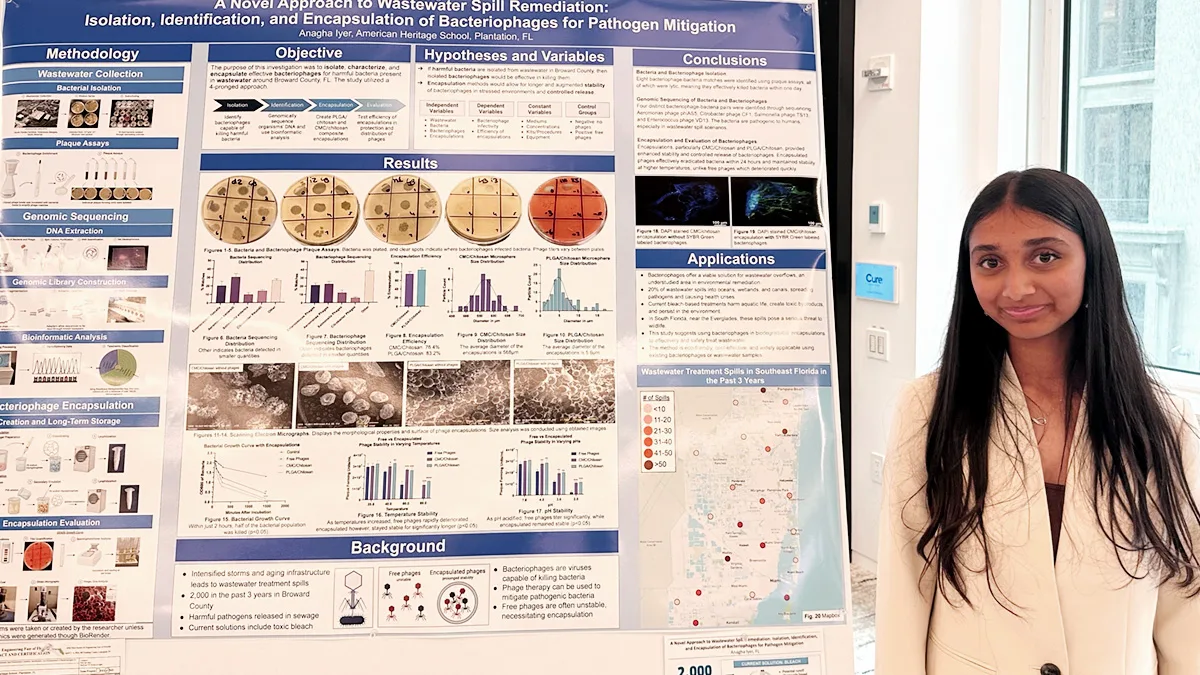
Overview
Developing a novel noninvasive and environmentally friendly approach to treat waste spills in Florida earned high schooler Anagha Iyer finalist honors in the 2024 BioGENEius Challenge.
Exploring noninvasive and environmentally friendly approach to waste water remediation
Novel research on treating waste water spills using microbes earned Anagha Iyer, a tenth grade student from American Heritage School in Plantation, FL, a finalist position in the 2024 BioGENEius Challenge. Specifically, she leveraged bacteriophages, viruses capable of killing bacteria, as a noninvasive and environmentally friendly approach to waste water remediation.
The esteemed competition, founded by the Biotechnology Institute more than two decades ago, showcases the finest young talent in biotechnology from across the United States. Cure hosted the 2024 BioGENEius Challenge ceremonies, awarding a $500 prize to Iyer and three other finalists as well as top prize of $2,500 to Yifan Ding.
The students also toured labs at CURE and met with biopharma executives to discuss careers in the field of biotechnology. Since its inception, the BioGENEius Challenge has seen its alumni go on to impactful careers as entrepreneurs, physicians, healthcare leaders, and champions for sustainable health and environmental solutions.
Iyer spoke with Cure about what inspired her, challenges she faced and the journey she took for her project, “A Novel Approach for Wastewater Spill Remediation: Isolation, Identification, and Encapsulation of Bacteriophages for Pathogen Mitigation.”
This interview was edited for length and clarity.
Cure: Tell us about the inspiration behind your project? What problem were you hoping to solve?
Iyer: The inspiration from my project came when I heard recent news about a 500,000-gallon wastewater spill in my local neighborhood. This disease-carrying water was discharged into the Everglades where it caused multiple environmental and public health issues.
After seeing this, I learned that current municipal cleanup initiatives rely heavily on bleach, which can cause many downstream consequences. I aimed to find a more sustainable solution for dealing with the pathogenic bacteria in these spills.
Cure: What was the biggest challenge you faced while working on your project, and how did you overcome it?
Iyer: The biggest challenge I faced was finding local wastewater plants that were willing to provide samples to a high school student. Thankfully after reaching out to every city’s wastewater plant in Broward County, some were willing to provide the needed samples and were even intrigued to learn the results of my experiments!
Cure: What was the most surprising or unexpected result you encountered during your research?
Iyer: The most unexpected thing I found was that my encapsulated phages could actually kill bacteria at a faster rate than free phages (unencapsulated), perhaps because of the controlled release of phages into the environment.
Cure: How do you see the findings from your project being applied in the real world or in future scientific research?
Iyer: This technology can be applied to pathogenic bacteria found in wastewater, especially sewage that is discharged into natural environments where chemicals like bleach could have profound consequences.
I hope these encapsulated phages can also be used in areas suffering with contaminated drinking water where a certain bacteria could be causing specific problems. I see this research contributing significantly to the field of using bacteriophages for environmental remediation, which has currently not been extensively studied.
Cure: What role did mentorship or collaboration play in the success of your project?
Iyer: I had prodigious assistance from my research mentors at school: Juliana Caulkins, PhD, and Dr. Shaw. They helped develop my idea and work out the kinks and problems that came with the project ideation process.
I am also grateful to Florida International University for assisting me with lyophilization, University of Miami for giving me access to their confocal microscope, and American Heritage Boca Delray for their scanning electron microscope.
Cure: How has this experience influenced your academic or career goals? Do you have specific fields or industries in mind?
Iyer: After conducting this research, I can confidently say I am interested in furthering my research career in microbiology and environmental sciences. I hope when I enter a university I am able to work in a lab with similar interests to mine, where I can help save our planet from destructive environmental catastrophes such as wastewater treatment spills.
Cure: What advice would you give to other students interested in participating in the BioGENEius Challenge?
Iyer: Don’t be afraid to take risks and be ambitious! You can only control your own work, so do things that might seem out of the ordinary.
Also, be passionate about your work as you’ve spent time and effort, and make others feel the same way.
How Iyer describes her project:
One of the biggest environmental crises in the state of Florida is wastewater spills. With nearly 6,000 occurring in just the past three years in Florida, these spills pose a large risk to human and marine life, as pathogenic bacteria are circulated amongst communities.
Current solutions are unnatural and involve pouring bleach over infected areas. However, this can have many secondary consequences including toxic runoff, harmful byproducts, and toxicity to aquatic organisms.
This project aims to find a biologically based solution for wastewater treatment spills using bacteriophages, viruses capable of killing bacteria, as a noninvasive and environmentally friendly remediation method. In addition, the bacteriophages were encapsulated in a biodegradable capsule to allow for controlled release and augmented stability of the phages for real life applications.
By using bacteria found in local wastewater treatment plants in Broward County, FL, and isolating bacteriophages, unique matches were identified. It was discovered that encapsulated bacteriophages could kill 99 percent of the bacterial population in less than 24 hours.
In addition, the encapsulated conserved 37 percent of the phage concentration at elevated temperatures and pHs, demonstrating their ability to be deployed in harsh environmental conditions.
Encapsulated bacteriophages allowed for a new and innovative solution using naturally existing materials to combat a huge public-health and environmental issue in Florida.
The expected outcome of this research is to implement this technology in natural ecosystems, like the Florida Everglades, where pouring bleach could have disastrous effects otherwise.
Follow the BioGENEius Challenge on LinkedIn and our website: Technology Organization Serving in the US | Bio Technology Institute.








